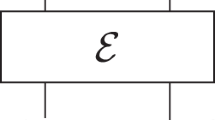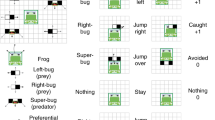Abstract
Traditionally, quantum theory assumes the existence of a fixed background causal structure. But if the laws of quantum mechanics are applied to the causal relations, then one could imagine situations in which the causal order of events is not always fixed, but is subject to quantum uncertainty. Such indefinite causal structures could make new quantum information processing tasks possible and provide methodological tools in quantum theories of gravity. Here, I review recent theoretical progress in this emerging area.
This is a preview of subscription content, access via your institution
Access options
Subscribe to this journal
Receive 12 print issues and online access
$209.00 per year
only $17.42 per issue
Buy this article
- Purchase on Springer Link
- Instant access to full article PDF
Prices may be subject to local taxes which are calculated during checkout


Similar content being viewed by others
References
Pearl, J. Causality: Models, Reasoning, and Inference (Cambridge Univ. Press, 2000).
Kochen, S. & Specker, E. P. The problem of hidden variables in quantum mechanics. J. Math. Mech. 17, 59 (1967).
Bell, J. S. On the Einstein–Podolsky–Rosen paradox. Physics 1, 195–200 (1964).
DeWitt, B. S. Quantum theory of gravity I. The canonical theory. Phys. Rev. 160, 1113–1148 (1967).
Peres, A. Measurement of time by quantum clocks. Am. J. Phys. 48, 552–557 (1980).
Wooters, W. K. 'Time' replaced by quantum correlations. Int. J. Theor. Phys. 23, 701–711 (1984).
Rovelli, C. Quantum mechanics without time: a model. Phys. Rev. D 42, 2638–2646 (1990).
Isham, C. in Integrable Systems, Quantum Groups and Quantum Field Theory (ed. Ibort, R.) 157–287 (Kluwer, 1993).
Gambini, R., Porto, R. A. & Pullin, J. A relational solution to the problem of time in quantum mechanics and quantum gravity: a fundamental mechanism for quantum decoherence. New J. Phys. 6, 45 (2004).
Hardy, L. Probability theories with dynamic causal structure: a new framework for quantum gravity. Preprint at http://arxiv.org/abs/gr-qc/0509120 (2005).
Hardy, L. Towards quantum gravity: a framework for probabilistic theories with non-fixed causal structure. J. Phys. A 40, 3081 (2007).
Chiribella, G., D'Ariano, G. M., Perinotti, P. & Valiron, B. Quantum computations without definite causal structure. Phys. Rev. A 88, 022318 (2013).
Oreshkov, O., Costa, F. & Brukner, C. Quantum correlations with no causal order. Nature Commun. 3, 1092 (2012).
Leifer, M. S. & Spekkens, R. W. Towards a formulation of quantum theory as a causally neutral theory of Bayesian inference. Phys. Rev. A 88, 052130 (2013).
Müller, M. P. & Masanes, L. Three-dimensionality of space and the quantum bit: an information-theoretic approach. New J. Phys. 15, 053040 (2013).
Dakic, B. & Brukner, C. in Quantum Theory: Informational Foundations and Foils (eds Chiribella, G. & Spekkens, R.) (Springer, in the press); Preprint at http://arxiv.org/abs/1307.3984 (2013).
Brukner, C., Taylor, S., Cheung, S. & Vedral, V. Quantum entanglement in time. Preprint at http://arxiv.org/abs/quant-ph/0402127v1 (2004).
Leifer, M. S. Quantum dynamics as an analog of conditional probability. Phys. Rev. A 74, 042310 (2006).
Marcovitch, S. & Reznik, B. Structural unification of space and time correlations in quantum theory. Preprint at http://arxiv.org/abs/1103.2557 (2011).
Fitzsimons, J., Jones, J. & Vedral, V. Quantum correlations which imply causation. Preprint at http://arxiv.org/abs/1302.2731 (2013).
Cirel'son, B. C. Quantum generalizations of Bell's inequality. Lett. Math. Phys. 4, 93 (1980).
Leggett, A. J. & Garg, A. Quantum mechanics versus macroscopic realism: Is the flux there when nobody looks? Phys. Rev. Lett. 54, 857 (1985).
Fritz, T. Quantum correlations in the temporal Clauser–Horne–Shimony–Holt (CHSH) scenario. New J. Phys. 12, 083055 (2010).
Budroni, C., Moroder, T., Kleinmann, M. & Gühne, O. Bounding temporal quantum correlations. Phys. Rev. Lett. 111, 020403 (2013).
Markiewicz, M., Przysiezna, A., Brierley, S. & Paterek, T. Genuinely multi-point temporal quantum correlations. Preprint at http://arxiv.org/abs/1309.7650 (2013).
Kleinmann, M., Gühne, O., Portillo, J. R., Larsson, J-Å. & Cabello, A. Memory cost of quantum contextuality. New J. Phys. 13, 113011 (2011).
Hardy, L. Reformulating and reconstructing quantum theory. Preprint at http://arxiv.org/abs/1104.2066 (2011).
Chiribella, G., D'Ariano, G. M. & Perinotti, P. Theoretical framework for quantum networks. Phys. Rev. A 80, 022339 (2009).
Jamiołkowski, A. Linear transformations which preserve trace and positive semidefiniteness of operators. Rep. Math. Phys. 3, 4, 275–278 (1972).
Choi, M-D. Completely positive linear maps on complex matrices. Lin. Alg. Applic. 10, 285–290 (1975).
Coecke, B. Kindergarten quantum mechanics. Preprint at http://arxiv.org/abs/quant-ph/0510032 (2005).
Caves, C. M., Fuchs, C. A. & Schack, R. Quantum probabilities as Bayesian probabilities. Phys. Rev. A 65, 022305 (2002).
Gödel, K. An example of a new type of cosmological solution of Einstein's field equations of gravitation. Rev. Mod. Phys. 21, 447–450 (1949).
Deutsch, D. Quantum mechanics near closed timelike lines. Phys. Rev. D 44, 3197–3217 (1991).
Greenberger, D. M. & Svozil, K. in Quo Vadis Quantum Mechanics? (eds Elitzur A. Dolev, S. & Kolenda, N.) 63–72 (Springer, 2005).
Svetlichny, G. Effective quantum time travel. Int. J. Theor. Phys. 50, 3903 (2011).
Lloyd, S. et al. Closed timelike curves via post-selection: theory and experimental demonstration. Phys. Rev. Lett. 106, 040403 (2011).
Gisin, N. Weinberg's non-linear quantum mechanics and supraluminal communications, Phys. Lett. A 143, 1–2 (1990).
Clauser, J. F., Horne, M. A., Shimony, A. & Holt, R. A. Proposed experiment to test local hidden-variable theories. Phys. Rev. Lett. 23, 880 (1969).
Baumeler, Ä. & Wolf, S. Perfect signaling among three parties violating predefined causal order. Preprint at http://arxiv.org/abs/1312.5916 (2013).
Greenberger, D., Horne, M., Shimony, A. & Zeilinger, A. Bell's theorem without inequalities. Am. J. Phys. 58, 1131 (1990).
Hardy, L. in Proc. Quantum Reality, Relativistic Causality, and Closing the Epistemic Circle: Int. Conf. in Honour of Abner Shimony. Preprint at http://arxiv.org/abs/quant-ph/0701019 (2007).
Chiribella, G. Perfect discrimination of no-signalling channels via quantum superposition of causal structures. Phys. Rev. A 86, 040301(R) (2012).
Araújo, M., Costa, F. & Brukner, C. Decrease in query complexity for quantum computers with superposition of circuits. Preprint at http://arxiv.org/abs/1401.8127 (2014).
Nielsen, M. A. & Chuang, I. L. Quantum Computation and Quantum Information (Cambridge Univ. Press, 2000).
Acknowledgements
I thank F. Costa, O. Oreshkov and J. Pienaar for discussions. This work was supported by the Austrian Science Fund (FWF) through FoQuS and individual project 24621, the European Commission Project RAQUEL, FQXi, and the John Templeton Foundation.
Author information
Authors and Affiliations
Corresponding author
Ethics declarations
Competing interests
The author declares no competing financial interests.
Rights and permissions
About this article
Cite this article
Brukner, Č. Quantum causality. Nature Phys 10, 259–263 (2014). https://doi.org/10.1038/nphys2930
Received:
Accepted:
Published:
Issue Date:
DOI: https://doi.org/10.1038/nphys2930
This article is cited by
-
Quantum causality emerging in a delayed-choice quantum Cheshire Cat experiment with neutrons
Scientific Reports (2023)
-
Device-independent certification of indefinite causal order in the quantum switch
Nature Communications (2023)
-
Strategies for single-shot discrimination of process matrices
Scientific Reports (2023)
-
Indefinite causal order with fixed temporal order for electrons and positrons
Quantum Studies: Mathematics and Foundations (2023)
-
Robustness of noisy quantum networks
Communications Physics (2022)



